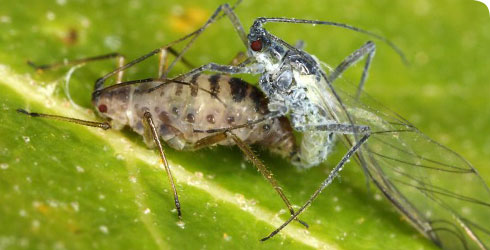Biology

In a few weeks these nymphs have developed into adults, and by June their offspring are themselves producing young, so by the time the tree is fully in leaf there may be very large numbers of aphids. © Jarmo Holopainen
Like other aphids, all the birch aphids you see in spring and summer are female.
They give birth to live young without mating (parthenogenesis), producing clones of themselves.
This method of reproduction enables them to build up large populations very quickly on the nutritious young spring growth.
E. betulae is first found in early April, as young nymphs that have hatched from overwintering eggs. They feed on breaking buds and expanding leaves.
After a few weeks these nymphs have developed into adults, and by June their offspring are themselves producing young. By the time the tree is fully in leaf there may be very large numbers of aphids.
When the leaves are mature they are less nutritious, so during July and August E. betulae stops producing young.
In September, when the food accumulated in the leaves throughout the summer starts to be broken down and translocated to the roots of the tree prior to leaf-fall, the sap becomes full of nutrients again and a new generation of winged adults develops.
These prefer to feed on the most nutritious, yellowing leaves.
The next generation of E. betulae become adult in October-November and look completely different.
This generation consists of winged males and wingless brown egg-laying females.
In the eggs that develop inside these females, the chromosomes have undergone meiosis - a process in which they pair and exchange parts, generating new combinations of genes.
This annual sexual generation in autumn, after months of clonal reproduction, ensures that the following year’s aphids will have the genetic diversity needed to survive another year.
When the female has mature eggs inside her, mating occurs and she lays her eggs on birch twigs.
The eggs are bright orange-yellow when first laid but soon become shiny black.
Aphids overwinter as eggs, and in spring the life cycle of the birch aphid starts afresh.
